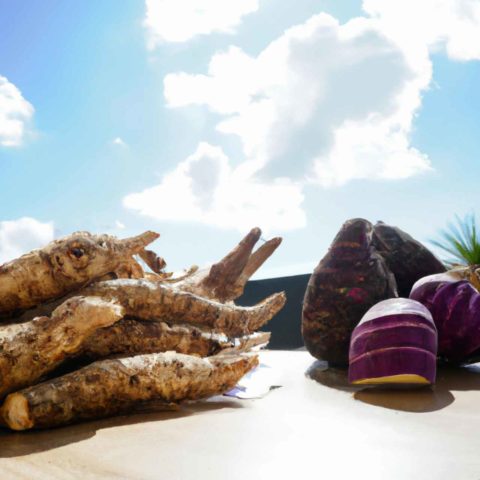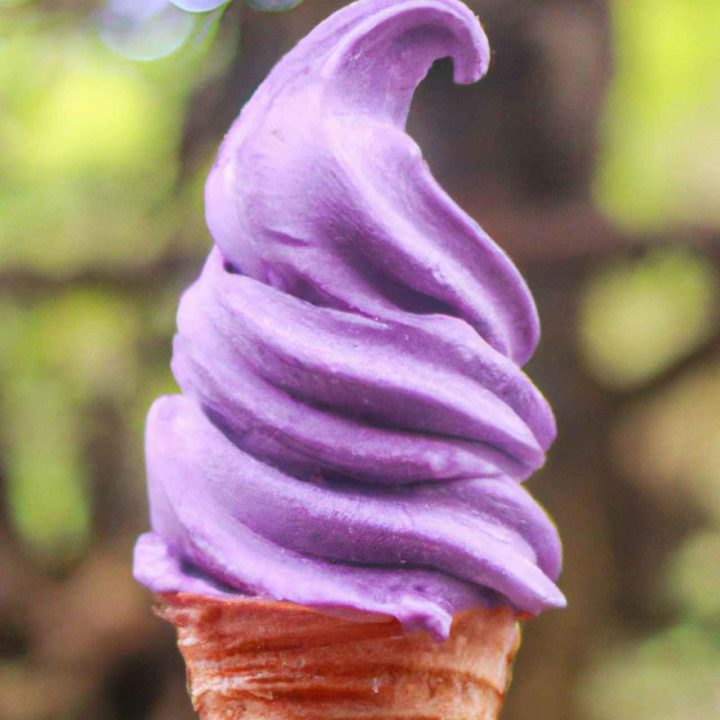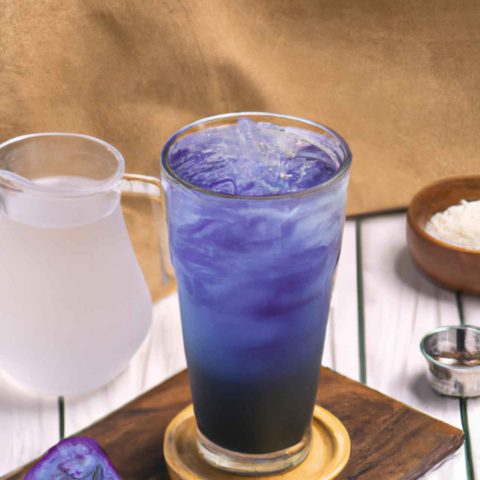Ube Vs Taro in 2024
Ube and Taro are usually confused as the same ingredients in several food and drinks. However, they have different origins, flavors, and uses.
Ube is a Japanese word for purple yam (okinawan sweet potato), while Taro is an Asian tuberous root vegetable that has been cultivated since ancient times.
The two vegetables can be used interchangeably, but they have some differences.
With that, let us get into the details of the differences between Taro and Ube.
Ube extract or ube powder is used in baking, and ice cream. Another very popular use is in cold drinks and bubble tea, especially when mixed with coconut milk.
In a Bubble tea, powdered ube is commonly used, with tapioca pearls giving a sweet flavor.
My favorite Ube backing product is an ube donut with powdered ube for the color and taro powder for the taste.
What is the Difference Between Ube and Taro
First of all, let us start this by getting to know the origins of Ube and Taro.
Ube is a kind of root crop and staple food native to Japan. It was first introduced in China during the Edo period.
In fact, it was called “Chinese Yam” at that time because its shape resembles Chinese yams. Later on, it became popular among people who were interested in traditional foods.
Countries in Southeast Asia, such as the Philippines, usually use Ube as the main ingredient in most Filipino desserts or Filipino cuisine. One of which is the Ube Halaya, which utilizes purple flesh.
You can also find this in some parts of Africa and South America, and in Japan as an okinawan purple sweet potato where it is often made into a sweet treat.
Meanwhile, Taro originated from South East Asia. Its name comes from the Malay language, which means ‘tuber’ or ‘root.’ There are many Taro plants with various colors ranging from white to yellow-orange. They grow well even under adverse conditions like drought and high temperatures. Taro is usually used as the main ingredient of soups and stews. Some countries in Africa prefer using Taro instead of rice when making porridge.
Now that we know about their origin, let us move on to the next part: what makes these two vegetables so distinct? Well, here are the answers!
What Does Taro Taste Like in Bubble Tea?
Difference 1 – Appearance and Texture
Ube looks more similar to a sweet potato than other types of tubers. It is usually mistaken as a purple sweet potato. Moreover, it has smooth skin, soft flesh, and purple color on the inside.

Meanwhile, Taro’s roots look much bigger compared to those of Ube. Also, unlike Ube, Taro does not contain starch. Instead, it contains carbohydrates and proteins. These characteristics make both vegetables very versatile. You can cook them in any way you want, depending on your preference. In addition, Ube is often served raw due to its firm texture.
In contrast, a raw Taro root tends to become softer after cooking with light purple color or white flesh because it is a starchy vegetable.
Therefore, if you plan to eat either one of them uncooked, then choose Ube over Taro.
Otherwise, go ahead and try out Taro. If you do decide to prepare Taro, remember to boil it before eating to get the best of its starchy texture. That will help soften up its hard and rough exterior.
Difference 2 – Flavor
Both Ube and Taro taste sweet and sour. But, how exactly do they differ? Let’s find out!

The flavor of Ube depends on the variety of the plant. For example, Okinawan types tend to have sweeter tastes. This is why they are commonly found in sweets and snacks. But most of the time, it gives a sweet and starchy taste, which is usually added to desserts and sweetened drinks like smoothies and milkshakes.
Meanwhile, Taro also varies according to the type of soil where it grows. Soil rich in minerals gives off stronger smells. As a result, Taro becomes tastier with a nutty flavor. It has a more earthy, flavorful taste that is great for savory dishes.
The difference in flavor may seem subtle, but it matters a lot. When choosing between the two, consider whether you would instead enjoy something sweet or savory. Then, pick whichever suits your preferences best.
- Is taro or ube better
- Is taro milk tea ube
Best Dishes to Mix In
In Asian food, Ube is commonly in many desserts and pastries. If you explore its wide variety of food, you will see that Ube is mostly paired with milk, cheese, and cream cheese. Here are some examples:
1. Ube Halaya
This dessert consists of steamed Ube mixed with vanilla ice cream and topped with chocolate sauce. The combination creates an amazing aroma and flavors.
2. Ube Cake
If you love cakes, this recipe might be just right for you. All you need to do is mix together flour, sugar, eggs, butter, baking powder, salt, and water. Afterward, add in grated coconut flakes, green tea leaves, and ground nutmeg. And ube donut, with ube flavor.

3. Creamy Ube Jelly
If you’re looking for a jelly-like dish, this creamy version is perfect for you. Just combine gelatin, boiling water, corn syrup, lemon juice, and powdered sugar. Add in sliced Ube and stir well until all ingredients dissolve completely. Pour into molds and refrigerate overnight. Enjoy chilled!
On the other hand, Taro is commonly mixed with savory dishes because of its nutty and earthly flavor. It goes well with spices, baked dishes, red beans, etc. If you want to know what recipes are best for Taro, here are some of them:
1. Baked Taro
Bake Taro is done by mixing rice flour, egg yolks, oil, and salt. Bake at 350 degrees Fahrenheit for about 30 minutes. Serve hot or cold.
2. Red Beans With Taro
One of the most basic dishes from Taro is combining it with red beans. Combine boiled taro root with soybeans, garlic, ginger, onion, and chili pepper. Cook these ingredients in vegetable broth for 20 minutes. Once cooked, remove from heat and serve warm.
3. Fried Rice With Taro Root
This dish is a mix of fried rice noodles with shredded cabbage, carrots, bean sprouts, scallions, sesame seeds, and chopped taro roots. Season with black pepper and sprinkle with sesame oil. Heat in a wok for 3-5 minutes. Garnish with cilantro sprigs.
Nutritional Content
When it comes to nutritional content, Ube is popular for containing a handful of vitamins and minerals. These include:
- vitamin A, C, E, K
- calcium
- iron
- magnesium
- phosphorus
- potassium
- zinc
- copper
- manganese
- selenium
- iodine
- fiber
Meanwhile, Taro contains high amounts of:
- protein
- carbohydrates
- dietary fibers
- folates
- riboflavin
- niacin
- thiamine
- pantothenic acid
- ascorbic acid
- sodium
- phosphorous
- potassium
- iron
- magnesium
Health Benefits
Both Ube and Taro have their benefits when used as part of our diet. For example, they can help us lose weight if we eat enough of them. They also contain antioxidants that protect against cancerous cells. Both foods are rich sources of fiber, so they keep us full longer. Individually, they have their benefits when it comes to health and culinary purposes.
You can see a medically researched paper also on the medicinal properties of these two.
For instance, Ube gives benefits such as:
- It helps lower cholesterol levels.
- Detoxifies the body.
- Help lower blood pressure.
- Help manage blood sugar.
- Prevents symptoms of asthma.
- Improves gut health.
- Good source of carbohydrates.
For Taro, it has many benefits like:
- Helps prevent heart disease.
- Improves vision.
- Improves skin health
- Protects brain function.
- Promotes good digestion.
- Provides energy.
- Prevents cancer.
How to Tell Ube and Taro Apart

Ube and taro are two popular asian ingredients that look very similar. The easiest way to tell them apart is by looking at the skin, ube will have a purple tinge under the brown outer skin, whereas the taro skin is thicker, more coarse, and sometimes even slightly hairy!
Are Taro and Ube the same as a purple sweet potato?
No, not really. Sweet potato or purple potato comes in different colors but none of them look like either one of those two. Sweet potatoes also have smoother skin and do not stain, unlike Ube that heavily stains, hence it is also used as a food coloring. Moreover, a slice of sweet potato is way sweeter than Taro and Ube, even without milk or sugar.
Which is sweeter, Taro or Ube?
In most desserts and dishes, Ube is sweeter than Taro. Thinks starchy tuber. As mentioned above, Ube is usually used in desserts like ice cream, milkshakes, puddings, and more. Meanwhile, taro is less sweet, which is the reason why it is mixed in savory food.
What makes Taro show a purple color?
Taro shows this color due to anthocyanins which give it its deep blue hue. Anthocyanins are pigments found in plants that provide protection against UV rays. This protects the plant’s leaves and stems from damage caused by sunlight. The pigment is responsible for giving Taro its dark-purple appearance.
What makes Ube show a purple color?
The reason why Ube turns purple is because of anthocyanins. It is similar to how Taro does. However, there are some differences between both fruits. One difference is that Taro grows underground while Ube grows on top of the ground.
Ube muffins and Jasmine Tea Taste go well together.
Is Ube Sweeter than Taro?
Today, ube is commonly used in desserts and drinks, especially smoothies and tends to be sweeter than Taro which is another popular root vegetable that originated in Asia.
Like ube, taro is widely used in Asian cuisine.
While both ube and taro are delicious, they aren’t exactly interchangeable. Ube tends to be sweeter while taro is milder.
Also, ube is typically cooked until soft, whereas taro is usually boiled.